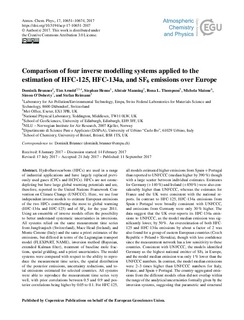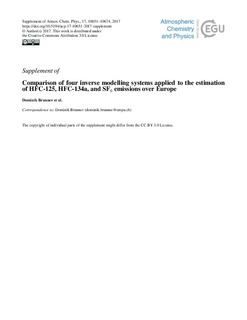| dc.description.abstract | Hydrofluorocarbons (HFCs) are used in a range of industrial applications and have largely replaced previously used gases (CFCs and HCFCs). HFCs are not ozone-depleting but have large global warming potentials and are, therefore, reported to the United Nations Framework Convention on Climate Change (UNFCCC). Here, we use four independent inverse models to estimate European emissions of the two HFCs contributing the most to global warming (HFC-134a and HFC-125) and of SF6 for the year 2011. Using an ensemble of inverse models offers the possibility to better understand systematic uncertainties in inversions. All systems relied on the same measurement time series from Jungfraujoch (Switzerland), Mace Head (Ireland), and Monte Cimone (Italy) and the same a priori estimates of the emissions, but differed in terms of the Lagrangian transport model (FLEXPART, NAME), inversion method (Bayesian, extended Kalman filter), treatment of baseline mole fractions, spatial gridding, and a priori uncertainties. The model systems were compared with respect to the ability to reproduce the measurement time series, the spatial distribution of the posterior emissions, uncertainty reductions, and total emissions estimated for selected countries. All systems were able to reproduce the measurement time series very well, with prior correlations between 0.5 and 0.9 and posterior correlations being higher by 0.05 to 0.1. For HFC-125, all models estimated higher emissions from Spain + Portugal than reported to UNFCCC (median higher by 390 %) though with a large scatter between individual estimates. Estimates for Germany (+140 %) and Ireland (+850 %) were also considerably higher than UNFCCC, whereas the estimates for France and the UK were consistent with the national reports. In contrast to HFC-125, HFC-134a emissions from Spain + Portugal were broadly consistent with UNFCCC, and emissions from Germany were only 30 % higher. The data suggest that the UK over-reports its HFC-134a emissions to UNFCCC, as the model median emission was significantly lower, by 50 %. An overestimation of both HFC-125 and HFC-134a emissions by about a factor of 2 was also found for a group of eastern European countries (Czech Republic + Poland + Slovakia), though with less confidence since the measurement network has a low sensitivity to these countries. Consistent with UNFCCC, the models identified Germany as the highest national emitter of SF6 in Europe, and the model median emission was only 1 % lower than the UNFCCC numbers. In contrast, the model median emissions were 2–3 times higher than UNFCCC numbers for Italy, France, and Spain + Portugal. The country-aggregated emissions from the different models often did not overlap within the range of the analytical uncertainties formally given by the inversion systems, suggesting that parametric and structural uncertainties are often dominant in the overall a posteriori uncertainty. The current European network of three routine monitoring sites for synthetic greenhouse gases has the potential to identify significant shortcomings in nationally reported emissions, but a denser network would be needed for more reliable monitoring of country-wide emissions of these important greenhouse gases across Europe. | |


